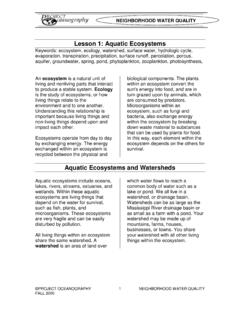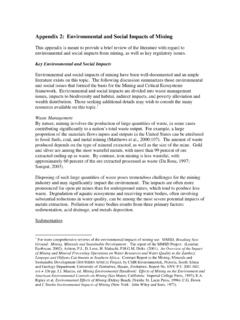Transcription of Chapter 14: HAZARDOUS TO THE AQUATIC ENVIRONMENT ...
1 Chapter 14: HAZARDOUS TO THE AQUATIC ENVIRONMENT DEFINITIONS AND DATA REQUIREMENTS 1. The basic elements for use within the harmonised system are: - acute AQUATIC toxicity; - potential for or actual bioaccumulation; - degradation (biotic or abiotic) for organic chemicals; and - chronic AQUATIC toxicity. 2. While data from internationally harmonised test methods are preferred, in practice, data from national methods may also be used where they are considered as equivalent. In general, it has been agreed that freshwater and marine species toxicity data can be considered as equivalent data and are preferably to be derived using OECD Test Guidelines or equivalent according to the principles of GLP.
2 Where such data are not available classification should be based on the best available data. Acute toxicity 3. Acute AQUATIC toxicity would normally be determined using a fish 96 hour LC50 (OECD Test Guideline 203 or equivalent), a crustacea species 48 hour EC50 (OECD Test Guideline 202 or equivalent) and/or an algal species 72 or 96 hour EC50 (OECD Test Guideline 201 or equivalent). These species are considered as surrogate for all AQUATIC organisms and data on other species such as Lemna may also be considered if the test methodology is suitable. Bioaccumulation potential 4. The potential for bioaccumulation would normally be determined by using the octanol/water partition coefficient, usually reported as a log Kow determined by OECD Test Guideline 107 or 117.
3 While this represents a potential to bioaccumulate, an experimentally determined Bioconcentration Factor (BCF) provides a better measure and should be used in preference when available. A BCF should be determined according to OECD Test Guideline 305. Rapid degradability 5. Environmental degradation may be biotic or abiotic ( hydrolysis) and the criteria used reflect this fact (Annex I). Ready biodegradation can most easily be defined using the OECD biodegradability tests OECD Test Guideline 301 (A - F). A pass level in these tests can be considered as indicative of rapid degradation in most environments. These are freshwater tests and thus the use of the results from OECD Test Guideline 306 which is more suitable for marine environments has also been included.
4 Where such data are not available, a BOD(5 days)/COD ratio > is considered as indicative of rapid degradation. 6. Abiotic degradation such as hydrolysis, primary degradation, both abiotic and biotic, degradation in non- AQUATIC media and proven rapid degradation in the ENVIRONMENT may all be considered in defining rapid degradability. Special guidance on data interpretation will be provided in the Guidance Document. 2 Chronic toxicity 7. Chronic toxicity data are less available than acute data and the range of testing procedures less standardised. Data generated according to the OECD Test Guidelines 210 (Fish Early Life Stage), or 211 (Daphnia Reproduction) and 201 (Algal Growth Inhibition) can be accepted.
5 Other validated and internationally accepted tests could also be used. The NOECs or other equivalent L(E)Cx should be used. CONSIDERATIONS 8. The harmonised system for classifying chemical substances for the hazards they present to the AQUATIC ENVIRONMENT is based on a consideration of systems existing at the time. The AQUATIC ENVIRONMENT may be considered in terms of the AQUATIC organisms that live in the water, and the AQUATIC ecosystem of which they are part. To that extent, the proposal does not address AQUATIC pollutants for which there may be a need to consider effects beyond the AQUATIC ENVIRONMENT such as the impacts on human health etc. The basis, therefore, of the identification of hazard is the AQUATIC toxicity of the substance, although this may be modified by further information on the degradation and bioaccumulation behaviour.
6 9. The proposed system is intended specifically for use with chemical substances and is not intended at this stage to cover preparations or other mixtures such as formulated pesticides. While the scheme is intended to apply to all substances, it is recognised that for some substances, metals, poorly soluble substances etc., special guidance will be necessary. 10. A Guidance Document has been prepared to cover issues such as data interpretation and the application of the criteria defined below to such groups of substances. Considering the complexity of this endpoint and the breadth of the application of the system, the Guidance Document is considered an important element in the operation of the harmonised scheme (see Annex 3).
7 11. Consideration has been given to existing classification systems as currently in use, including the EU Supply and Use Scheme, the revised GESAMP hazard evaluation procedure, IMO Scheme for Marine Pollutant, the European Road and Rail Transport Scheme (RID/ADR), the Canadian and US Pesticide systems and the US Land Transport Scheme. The harmonised scheme is considered suitable for use for packaged goods in both supply and use and multimodal transport schemes, and elements of it may be used for bulk land transport and bulk marine transport under MARPOL 73/78 Annex II insofar as this uses AQUATIC toxicity. 12. The harmonised classification system for substances consists of three acute classification categories and four chronic classification classes.
8 The acute and the chronic classification categories are applied independently. The criteria for classification of a substance in acute categories I to III are defined on the basis of the acute toxicity data only (EC50 or LC50). The criteria for classification of a substance into chronic categories combine two types of information, acute toxicity data and environmental fate data (degradability and bioaccumulation data). For assignment of mixtures to chronic categories, degradation and bioaccumulation properties are derived from tests on components. CLASSIFICATION CRITERIA FOR SUBSTANCES 13. The harmonised classification system for substances consists of three acute classification categories and four chronic classification categories.
9 The acute and the chronic classification categories are applied independently. The criteria for classification of a substance in acute categories I to III are 3defined on the basis of the acute toxicity data only (EC50 or LC50). The criteria for classification of a substance into chronic categories combine two types of information, acute toxicity data and environmental fate data (degradability and bioaccumulation data). For assignment of mixtures to chronic categories, degradation and bioaccumulation properties are derived from tests on components. 14. Substances classified under the following criteria will be categorised as HAZARDOUS to the AQUATIC ENVIRONMENT .
10 These criteria describe in detail the classification categories. They are diagrammatically summarised in Table 1. Category: Acute I Acute toxicity 96 hr LC50 (for fish) 1 mg/L and/or 48 hr EC50 (for crustacea) 1 mg/L and/or 72 or 96hr ErC50 (for algae or other AQUATIC plants) 1 mg/L. Category: Acute I may be subdivided for some regulatory systems to include a lower band at L(E)C50 mg/L. Category: Acute II 96 hr LC50 (for fish) >1 - 10 mg/L and/or 48 hr EC50 (for crustacea) >1 - 10 mg/L and/or 72 or 96hr ErC50 (for algae or other AQUATIC plants) >1 - 10 mg/L.
















